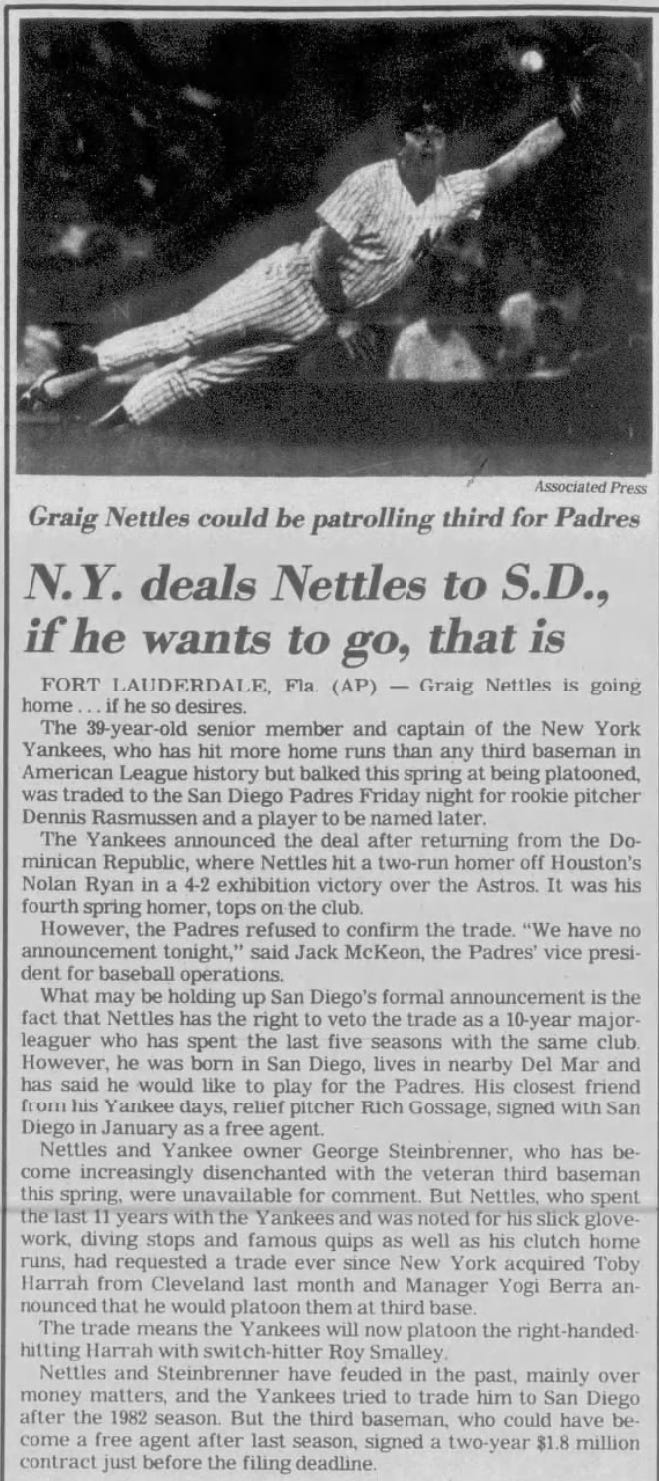Literally 1984
The year 1984 has turned into an Orwellian pejorative over the years — and the internet has only helped spread it.
However, for those of us who grew up fascinated with baseball history, 1984 has a different meaning entirely.
1984 wasn’t just the year that the Cubs rose from the ashes. It was also the year of the extremely surprising San Diego Padres — a team that rose from obscurity to the World Series itself, only to fall apart as quickly as it rose.
Look at what Bill James had to say about the Padres in 1980:
San Diego avoided 90 losses in 1980, but just barely. They went 73-89, good enough for last place in the NL West, 19 1/2 games out of first place. The losing team that James criticized so much looked like this:
In 1981, they spent both ends of the split season in last place.
After trading Ozzie Smith away at the end of the 1981 season, the Padres managed to make some improvements. The 1982 team managed an 81-81 record, thanks in large part to standout offensive seasons by young players such as Sixto Lezcano, Ruppert Jones, and catcher Terry Kennedy:
Of course, as you almost certainly know by now, the real future stars were already on the team in a part time role. Alan Wiggins was 24 years old and on the team after a good season and a half with Hawaii in the PCL, and Tony Gwynn played so well in half a season in Hawaii that he was up at the top to stay.
By 1983 the Padres had obtained Steve Garvey, a 34-year-old aging star who could still hit for average with some power. Though Garvey was sure to leave the Dodgers, there was some danger that he might join the Giants:
In the end, Garvey decided to stay in southern California — but was only able to help the Padres reach the 81-81 mark.
And that set things up for 1984.
Everything had to go right, of course. Wiggins made up for his lack of slugging by getting on base and playing well at second base. Youngsters Carmelo Martinez and Kevin McReynolds had breakout years. Tony Gwynn led the league in hitting.
The Padres also got lucky. 39-year-old veteran Graig Nettles was upset with the Yankees, and was suddenly on the market. Nettles wanted to go home — and so he wound up with the Padres for what would be a whirlwind season:
The 1984 lineup looked like this:
So what do we learn from the 1984 Padres about success?
You’ve got to be willing to part with your stars. There’s no question that Ozzie Smith was San Diego’s best bet for the future in 1980. Garry Templeton was never quite the shortstop that the Wizard was. However, opening up the potential salary room allowed the Padres to get the pieces they need to really compete.
You’ve got to take a chance on youth. The Padres would have never been much in 1984 if they had continued to buy 31 and 32 year old players instead of giving Carmelo Martinez, Kevin McReynolds, Tony Gwynn, and Alan Wiggins a chance. I’m sure anybody could tell that Gwynn (and likely Wiggins) were ready for the show — but you’ve got to actually play those guys when they’re on your roster. As recognizable as Dave Winfield was in 1980, I’d much rather have Tony Gwynn on my team in 1984.
You need the right veterans. Nettles was at the end of the line, sure — but his 108 OPS+, helped in large part by those 20 home runs, were extremely helpful in 1984. The same goes for Garvey: he was somewhat past his prime, but he was able to rise to the occasion when it really mattered.
You need some luck. Mark Thurmond had a career season in 1984, and Ed Whitson and the infamously erratic Eric Show pitched well. Nobody could have guessed that Craig Lefferts and Dave Dravecky would have such good seasons out of the bullpen. And, even though everybody knew about Goose Gossage before 1984, the key to using him well was to have a bullpen good enough to get to Gossage: note that the Goose only pitched 102 1/3 innings in 62 appearances, meaning that he wasn’t coming out in the 7th.
Did it last? Nope. Wiggins turned out to be a major liability because of his drug usage. Garvey and Nettles wound up being too old, and the Padres slid back down, going below .500 in 1986 and winding up in the cellar again in 1987.
Sometimes your luck runs out. Things might have been different if Wiggins had stayed clean and if Show had better mental health.
But, you know what? James was probably a bit too quick to dismiss the franchise as a laughing stock.










If you use a simple run estimator, like runs created, & run the same formula for the opposition, & then figure the pythagorean expectation for the differential, the Padres in 1982 probably should've been a few games under .500 & probably should've lost over 90 games in 1983. In 1984, the Padres created one more run than their opponents did, but won the division. In 1985, the Padres created one fewer run than their opposition did, & finished a tiny bit above .500.
Perhaps Dick Williams was a savant, or perhaps they were insanely lucky. Maybe both? But, either way, they did in fact move from being a laughingstock to being an adequate ballclub.
Ouch, shots fired at Ballard Smith there. All facts, still smacks.